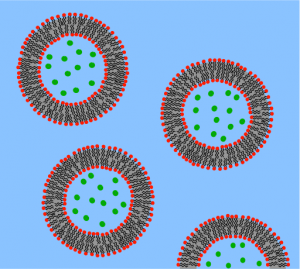 Communication between cells is ubiquitous in nature. Microbes use a language of chemical signals; human cells use a language of cytokines and neurotransmitters. There is increasing evidence for many other mechanisms of cellular communication including electrical signals and recently discovered nanotubes between animal cells. One of the major communication and transport devices used inside cells and between cells is a vesicle. Almost every cell uses vesicles in many different ways—for neurotransmitters, lysosomes cleaning debris, and for transfer of genetic material. Now, a new very widespread and important use of vesicles in ocean microbes has been discovered. This new process is critical to the earth’s production of carbon nutrients and oxygen and demonstrates many new ways that vesicles transport information.
Communication between cells is ubiquitous in nature. Microbes use a language of chemical signals; human cells use a language of cytokines and neurotransmitters. There is increasing evidence for many other mechanisms of cellular communication including electrical signals and recently discovered nanotubes between animal cells. One of the major communication and transport devices used inside cells and between cells is a vesicle. Almost every cell uses vesicles in many different ways—for neurotransmitters, lysosomes cleaning debris, and for transfer of genetic material. Now, a new very widespread and important use of vesicles in ocean microbes has been discovered. This new process is critical to the earth’s production of carbon nutrients and oxygen and demonstrates many new ways that vesicles transport information.
Communication between cells occurs at many different levels at the same time. Neurons communicate with electrical brain waves, electrical wired signals, and neurotransmitters in vesicles. Recently, neurons have been shown to send vesicles with proteins and DNA between each other and glia cells outside of the synapse. Previous posts have shown the varied ways that microbes communicate and fight by sending signals, making new 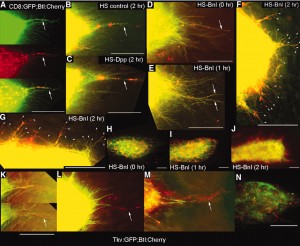 proteins and sending small RNAs. Cellular communication with molecules exists in all cells, not just microbes, including cytokines from immune cells and neurotransmitters from brain and immune cells.
proteins and sending small RNAs. Cellular communication with molecules exists in all cells, not just microbes, including cytokines from immune cells and neurotransmitters from brain and immune cells.
Recently, a totally new mechanism of cellular communication has been discovered. Ordinary human cells have been found to send long nanotubes, like axons, to distant cells to send nutrients, information and special molecules. These long thin tubes are now called cytonemes 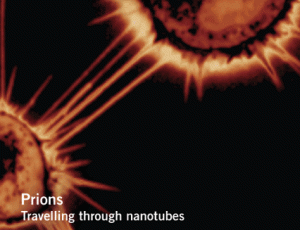 and can be the length of 100 cells. While common, these have not been noticed until now because of their extremely small size and fragility.
and can be the length of 100 cells. While common, these have not been noticed until now because of their extremely small size and fragility.
With so many different ways that cells communicate it is not surprising that vesicles are the transporters of critical information. An important new vesicle has just been discovered in marine photosynthetic microbes.
Marine Microbes Make Many Vesicles
Ocean phytoplankton is 1% of the world’s photosynthesis biomass, but produces 50% of the worldwide photosynthesis products. Prochlorococcus is the most prominent and the smallest photosynthesis cell. These microbes produce carbohydrates, such as sugars, from carbon dioxide and water. A byproduct of this process is oxygen.
Prochlorococcus, also, produces a large amount of vesicles that are used for many important functions: defense against viruses, transferring genetic information, and sending nutrients.
 All cells produce vesicles through a variety of mechanisms. Bacteria produce them with the outer membrane budding out and then pinching off the vesicle. The Prochlorococcus vesicles are elaborate with peri-plasmic and outer membrane proteins, as well as inner membrane and membranes from organelles inside the cytoplasm of the cell. They also contain DNA and RNA.
All cells produce vesicles through a variety of mechanisms. Bacteria produce them with the outer membrane budding out and then pinching off the vesicle. The Prochlorococcus vesicles are elaborate with peri-plasmic and outer membrane proteins, as well as inner membrane and membranes from organelles inside the cytoplasm of the cell. They also contain DNA and RNA.
Several other marine microbes, also, produce these vesicles, making it likely that it occurs throughout the entire ocean. These vesicles are produced in the open sea as well as more dense populations in biofilms. There are possibly ten times as many vesicles as microbes and they remain stable over time.
What is very surprising is that in the region of ocean where prochlorococcus lives there is very little carbon and other nutrients, and yet the microbe sends off large amounts of cellular nutrients in these vesicles.
 The carbon and nutrients in the vesicles feed microbes that cannot perform photosynthesis. It appears that Prochlorococcus needs other microbes for certain enzymes, catalase and catalase peroxidase, that are necessary to protect against damage from the very reactive oxygen produced in the photosynthesis process. Prochlorococcus is a very small effective microbe. Most microbes rid themselves of excess baggage by carrying the least amount of necessary DNA. They must, then, have friendly organisms nearby that will fulfill missing functions. This tendency to shed excess baggage occurs in our eukaryote cells as well, where the energy producing mitochondria gave up much of its functional DNA while living within the safety of the larger eukaryote cell. The bargain between energy producing mitochondria and protective larger eukaryote cells has worked very well.
The carbon and nutrients in the vesicles feed microbes that cannot perform photosynthesis. It appears that Prochlorococcus needs other microbes for certain enzymes, catalase and catalase peroxidase, that are necessary to protect against damage from the very reactive oxygen produced in the photosynthesis process. Prochlorococcus is a very small effective microbe. Most microbes rid themselves of excess baggage by carrying the least amount of necessary DNA. They must, then, have friendly organisms nearby that will fulfill missing functions. This tendency to shed excess baggage occurs in our eukaryote cells as well, where the energy producing mitochondria gave up much of its functional DNA while living within the safety of the larger eukaryote cell. The bargain between energy producing mitochondria and protective larger eukaryote cells has worked very well.
Also, Prochlorococcus vesicles transfer DNA between different organisms for horizontal gene transfer.
 In addition, the vesicles protect against attack by viruses. A previous post discussed the constant battle in the ocean between bacteria and the ten times greater number of phage viruses. About half of the bacteria are killed each day and the debris is a tremendous source of biomaterial for other creatures.
In addition, the vesicles protect against attack by viruses. A previous post discussed the constant battle in the ocean between bacteria and the ten times greater number of phage viruses. About half of the bacteria are killed each day and the debris is a tremendous source of biomaterial for other creatures.
The large amount of vesicles floating near Prochlorococcus act as a decoy for the phage viruses. The vesicles are quite complex with their outer membrane having many receptors for phage virus. The phage virus has injected many of the vesicles. The vesicles, also, can include toxins for other predators of the Prochlorococcus.
Vesicles Made in Human Cells Also Are Critical
 Most molecules, such as DNA and proteins, are too large to pass through the pores of membranes. These large molecules are packaged in vesicles that can merge with membranes through very complex mechanisms using scaffolding molecules. In the human cells vesicles are produced at the Golgi and the endoplasmic reticulum and perform many different functions. These vesicles can deliver material inside the cell, or outside the cell.
Most molecules, such as DNA and proteins, are too large to pass through the pores of membranes. These large molecules are packaged in vesicles that can merge with membranes through very complex mechanisms using scaffolding molecules. In the human cells vesicles are produced at the Golgi and the endoplasmic reticulum and perform many different functions. These vesicles can deliver material inside the cell, or outside the cell.
To make a vesicle, specialized scaffolding proteins begin to assemble at the membrane lipid layer. They then pinch the membrane lipid bilayer, which bends. As the membrane bulges out more and more and bends more and more, the protein structure grows into a complex matrix in the shape of a circle. When the vesicle is completely formed, at some point, the scaffolding structure breaks apart and the vesicle travels on to the delivery point. When it comes in contact with another membrane, the same process forms in reverse. Scaffolding molecules build a structure between the vesicle and the membrane as it merges into the membrane, releasing the molecules to the other side. This extremely complex process involves hundreds of different docking molecules and motors.
A vesicle inside of a cell can have a completely different environment than the cell. One example of this is the lysosome that has powerful enzymes to eat defective proteins and microbes that are in the cell. If these enzymes escaped from the cell they could destroy the cell.
Many Kinds of Vesicle Functions
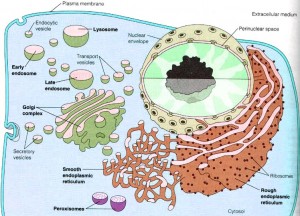 There are many kinds of vesicles. These are just a few important ones.
There are many kinds of vesicles. These are just a few important ones.
Lysosomes: These are vesicles used for waste disposal with enzymes to break down molecules
Transport Vesicles: These vesicles transport molecules inside of a cell from compartment to compartment, such from the endoplasmic reticulum, where they are manufactured, to other sites. Proteins that are secreted outside of the cell are packaged in vesicles. One of the main ways that products are taken into the blood is through an active process where cells’ membranes 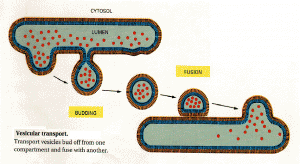 merge with a vesicle transporting it through the cell and secreting it on the other side into the blood stream.
merge with a vesicle transporting it through the cell and secreting it on the other side into the blood stream.
Vacuole Vesicles: Vacuoles are large vesicles that contain mostly water are used by plant cells for storage of food and osmotic control. Vesicles can take in water from the cell and secrete it outside to avoid too much water and bursting.
Secretion Vesicles: There are a large number of different types of vessels that secrete  signal molecules from the cell to the extra cellular region. The most well known are neurotransmitters that are secreted into the synaptic region triggered by an electric signal from the axon and calcium signaling. These vesicles merge with the membrane and then constantly recycle. A recent study showed that the recycling is very rapid, many times per second.
signal molecules from the cell to the extra cellular region. The most well known are neurotransmitters that are secreted into the synaptic region triggered by an electric signal from the axon and calcium signaling. These vesicles merge with the membrane and then constantly recycle. A recent study showed that the recycling is very rapid, many times per second.
Another type of secretion involves hormones from endocrine cells, such as insulin, which are stored in vesicles inside the cell. Vesicles also secrete enzymes that are essential for 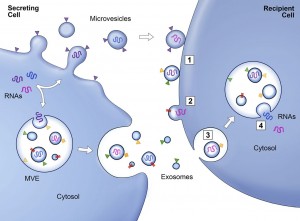 construction and maintenance of the extra cellular matrix and in plants the cell walls.
construction and maintenance of the extra cellular matrix and in plants the cell walls.
Gas Vesicles: There are vesicles that control the gas content of a microbe in order to better position the cell for light or for movement.
Extra cellular matrix vesicles: These vesicles can contain calcium, phosphate, lipids and necessary proteins to build bone matrix. These secretions are timed exactly to build bone at the correct time.
Vesicle Formation
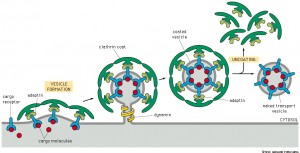 The coat layer is formed first and creates the shape of the bubble. It has signals and receptors that target specific molecules to be transported. The targeted molecules for transport cluster around this coat. There are different types of coat. Clathrin is used for most transport out of the cell and from the Golgi to the outer membrane.
The coat layer is formed first and creates the shape of the bubble. It has signals and receptors that target specific molecules to be transported. The targeted molecules for transport cluster around this coat. There are different types of coat. Clathrin is used for most transport out of the cell and from the Golgi to the outer membrane.
The vesicle has markings on the surface called SNARE, which both recognize the cargo, and also help fuse the vesicle membrane to the cell’s membrane. This is a very complex process with more than 36 different kinds of SNARE 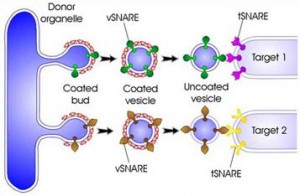 receptors for different types of cells and cargos and more than 60 different SNARE molecules. There are also multiple different proteins and motors that are necessary for this process to operate.
receptors for different types of cells and cargos and more than 60 different SNARE molecules. There are also multiple different proteins and motors that are necessary for this process to operate.
In order for the vesicle to fuse with or bud from the cell membrane they are brought extremely close together, which involves getting rid of water molecules between them. This is a difficult process and requires energy in the form of ATP.
Microbes Battle Over Vesicles With Other Microbes and Human Cells
Much of the life and death battle of microbes with other microbes, viruses and 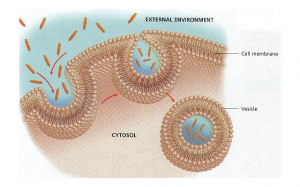 human cells plays out through vesicles. Microbes, viruses and human cells all can use vesicles for multiple different purposes.
human cells plays out through vesicles. Microbes, viruses and human cells all can use vesicles for multiple different purposes.
The viruses’ envelope is essentially a vesicle, which merges with the membrane and releases the virus into the cell. Enveloped viruses such as, rabies, HIV, Rous sarcoma virus and herpes simplex all enter the cell by fusing with the outer membrane. Other viruses try to create vesicle buds at the membrane and the membrane has factors to defend against this.
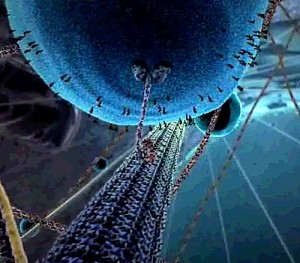 Microtubule motors transport vesicles carrying many different cargos including microbes. Rabies is carried by a vesicle retrograde from the tip of the axon all the way back to the nucleus. These vesicles are kept at specific pH to stop the release of the virus until it has travelled all the way to the nucleus.
Microtubule motors transport vesicles carrying many different cargos including microbes. Rabies is carried by a vesicle retrograde from the tip of the axon all the way back to the nucleus. These vesicles are kept at specific pH to stop the release of the virus until it has travelled all the way to the nucleus.
All microbes are able to make their own vesicles to transfer material. They have, also, been observed making their own viruses and injection mechanisms like phage viruses. A recent study showed that viruses might have evolved from small genetic elements that occur in all bacteria and are transferred between microbes often in vesicles.
Engulfment Into Vesicles
Engulfment into vesicles is a primary technique all through biology. Macrophage immune cells engulf microbes and wall them off in a vesicle. Microbes are tagged inside cells to be engulfed by vesicles. These sacs are routed to other larger vesicles with powerful enzymes to destroy them, called lysosomes and phagosomes. The phagophore is very large vesicle that can engulf even large microbes.
A battle ensues when microbes attempt to block the engulfing mechanisms using special proteins to trick the cells recognition mechanisms. The microbe also can break open the vesicle. Remarkably, some microbes are able to hijack the machinery of the vesicle and stop it from merging with the lysosome. The microbe can also block the vesicle producing machinery.
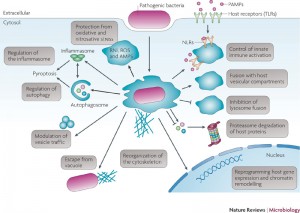 Most remarkable are microbes that block the molecules that will attach the vesicle to the lysosome and then live in the vesicle. By these processes, the vesicle, or vacuole, becomes a home for the microbe, called a niche. Living in this vesicle niche, the microbe is able to secrete a variety of proteins that attract necessary materials from the endoplasmic reticulum to manufacture factors and cellular parts.
Most remarkable are microbes that block the molecules that will attach the vesicle to the lysosome and then live in the vesicle. By these processes, the vesicle, or vacuole, becomes a home for the microbe, called a niche. Living in this vesicle niche, the microbe is able to secrete a variety of proteins that attract necessary materials from the endoplasmic reticulum to manufacture factors and cellular parts.
Neuronal Vesicles
As well as the well-known vesicle transport of the neurotransmitter, recently, totally new forms of neuronal communication have been discovered.
 Recently, it was found that neurons communicate genetic information between brain cells using vesicles, called exosomes. These vesicles transfer material in a manner similar to viruses. Neurons and glia transfer protein and genetic information in these sacs that are critical for neuronal function. Proteins and genetic information are secreted in vesicles from oligodendrocytes to be used by neurons for metabolism. These vesicles are fully absorbed and utilized by the neurons. Those neurons that receive it are able to better protect themselves with heat shock proteins, glycolytic enzymes and protection from oxidative stress. It is now, also, known that neurons expel and pick up vesicles with prion like proteins. A receptor for this vesicle has been found related to tau and amyloid beta.
Recently, it was found that neurons communicate genetic information between brain cells using vesicles, called exosomes. These vesicles transfer material in a manner similar to viruses. Neurons and glia transfer protein and genetic information in these sacs that are critical for neuronal function. Proteins and genetic information are secreted in vesicles from oligodendrocytes to be used by neurons for metabolism. These vesicles are fully absorbed and utilized by the neurons. Those neurons that receive it are able to better protect themselves with heat shock proteins, glycolytic enzymes and protection from oxidative stress. It is now, also, known that neurons expel and pick up vesicles with prion like proteins. A receptor for this vesicle has been found related to tau and amyloid beta.
Neuron Neurotransmitter Secretion With Vesicles
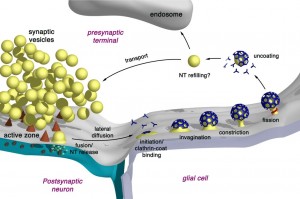 The neurotransmitter vesicle transport system is extremely complex involving rapid recycling of vesicles in milliseconds, using hundreds of complex interlocking motors and scaffolding molecules. Some of the vesicles are attached to a large complex called the active zone that provide docking, activating and priming.
The neurotransmitter vesicle transport system is extremely complex involving rapid recycling of vesicles in milliseconds, using hundreds of complex interlocking motors and scaffolding molecules. Some of the vesicles are attached to a large complex called the active zone that provide docking, activating and priming.
Axon tips contain approximately 200 vesicles, each 35 nanometers in diameter. Each vesicle has 2000 neurotransmitter molecules. Five to ten vesicles dock at active zones and some of these are primed and ready to go. When the action potential arrives calcium channels open triggering the vesicles to fuse with the membrane.
There are three neurotransmitter secretion mechanisms.
There is a fast and slow mode of re cycling of vesicles. After mild stimulation, the slow method takes 10 seconds and occurs with complete collapse of the vesicle needing rebuilding of the entire vesicle by clathrin and dynamin. With weak stimulation it takes a 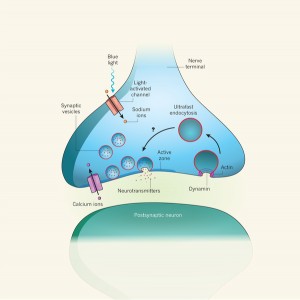 third of a second and involves the vesicle only partially fusing with the membrane, opening a pore, then reforming inside the cell – called kiss and run.
third of a second and involves the vesicle only partially fusing with the membrane, opening a pore, then reforming inside the cell – called kiss and run.
With prolonged stimulation, a third ultra fast mechanism has been recently discovered. Docked vesicles open fusion pores in 5 milliseconds. Active zones that have used all of their vesicles are fully stocked within 4 seconds. After exocytosis, the vesicle flattens into the neuron membrane. Endocytosis takes place starting at 5 ms, then large invaginations at 50 ms are formed. Upon reentering the cell, this process forms very large vesicles outside of the active zone. This process is not yet fully worked out.
Vesicles Transport Information
As well as the language of the shape of proteins in neurons, the language of microtubule scaffolding in neuroplasticity, the language of the genetic code, the language of epigenetic markings, the language of RNA and protein signaling, the language of cytokine communication among immune and brain cells, and the language of neurotransmitters, we now have to add the critical language of information transport by vesicles.
 The vesicle process is extremely complex involving machinery with hundreds of interlocking complex molecules and motors. What is most remarkable is that vesicles utilizing this elaborate machinery can recycle in milliseconds. While the mechanism itself is extremely complex and intelligent, the end result is, also, intelligent vesicle transfer of information in the form of DNA, RNA, proteins, nutrients and signals.
The vesicle process is extremely complex involving machinery with hundreds of interlocking complex molecules and motors. What is most remarkable is that vesicles utilizing this elaborate machinery can recycle in milliseconds. While the mechanism itself is extremely complex and intelligent, the end result is, also, intelligent vesicle transfer of information in the form of DNA, RNA, proteins, nutrients and signals.
With modern advanced techniques, totally new types of intelligent cellular communication are being found. Cells are hungry for information and communication and appear to utilize many different methods at once. These include not only vesicles, but also nanotubes between all cells. How can we not say that this vast information transfer is not intelligent cellular behavior?